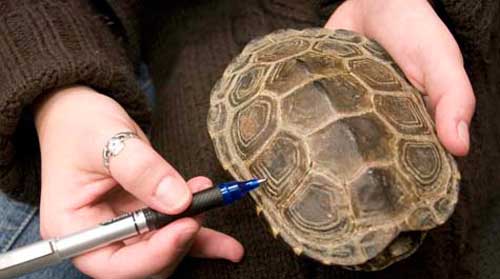Aging A Turtle: How Can You Tell How Old Is A Turtle?
So you don’t know how old is your turtle and have no idea how you can accurately age it? If yes, you’re not alone. Many other turtle owners have no idea how old their pet turtles are and are looking for help on how to age them. Luckily, this guide will help you out.
How can you tell how old is a turtle? You can determine the age of a turtle by counting the rings on its scutes or by measuring the length of its shell. Other helpful methods for aging a turtle include inspecting the shell rigidity, Skeletochronology method, or using visual aging cues.
In this guide, we’re going to share full details on how you can age your turtle. We’ll discuss the above methods for estimating the age of your turtle, whether you own a red-eared slider, box turtle, painted turtle, or any other turtle species.
How can you tell how old a turtle is?
Contents
The absolute best way to tell the age of your turtle is by knowing when your turtle was born.
Turtles from breeders who keep records may be easy to determine their ages since the breeders will provide you with their hatching dates.
However, this may not be possible in case you just rescued or adopted a turtle from a friend and don’t know how long they’ve had it.

This leaves you with the option of using other aging methods to estimate the turtle’s age. These include counting the rings on the shell scutes, measuring the turtle length, checking shell rigidity, etc.
But you should keep in mind that these methods will only give you a rough estimate and not the exact age of your pet turtle.
Let’s take a closer look at each of these aging methods:
Method #1. Count the rings on the scutes
One of the most common methods of determining turtle age involves counting the growth rings formed on the scutes.
For starters, scutes are the plates that make up the turtle’s shell. And they help give a rough estimate of how old a turtle is as they represent growth.
Don’t get it? A ring on the scute represents a growth spurt, even if the growth occurred over a pretty short period of time.
For instance, during a period of famine when the turtle doesn’t have food to eat or during the bountifulness period when the turtle has a lot of food to eat, the ring will still form.

The growth level of a turtle is usually determined by how much food is available for it to feed on.
You’ll notice that the rings on the scutes are either wider rings of one color or tinnier rings of a different color.
The wider ones denote periods when the turtle had a lot of food to eat while the narrower ones show periods of famine.
Now, when it comes to estimating the age, you simply count all the rings on the turtle scutes and then divide the total number by 2—this gives you the age of your turtle.
If, for instance, a turtle has 18 scutes, then you divide 18 by 2 and you get 9—meaning your turtle is roughly 9 years old.
Method #2. Measure the length of your turtle
This method involves measuring the straight length of the turtle carapace from head to toe. And it’s helpful if you want to know whether your turtle has reached sexual maturity age.
The method is based on the knowledge that turtles generally reach an average maximum shell length at maturity age.
Though their length may increase afterward, it’s usually insignificant as it happens at a much slower rate.
For you to use this turtle aging method, you must know the species of your turtle and its average shell length at maturity.
You then take your turtle’s carapace length (check out these instructions on how to measure turtle length) and compare it with that of the turtle species at maturity.
Keep in mind that the maximum length at maturity tends to differ between males and females for different spaces. So, you must also know the gender of your turtle for you to use this method.

Most small to medium-sized aquatic turtles hit sexual maturity at around 5-6 years. Females also tend to grow larger and faster than males.
One major downside of using this method is that it isn’t 100% accurate since turtles that eat more tend to grow faster compared to those that eat less.
Method #3. Check your turtle shell rigidity
Inspecting your turtle shell rigidity can also help you easily determine if it’s below 6 months or older. However, this method works better for turtle species that are NOT softshells.
Turtle shells usually take time to harden (usually around 6-8 months), which makes this method a good way to determine the animal’s age. A baby’s shell should feel spongy to the touch.
However, don’t press your turtle’s shell when using this method. Instead, touch it gently to avoid damaging the shell and harming the internal organs housed inside your turtle’s shell.
But beware that metabolic bone disease can also make your turtle’s shell soft, so you should confuse aging with this disease.
Method #4. Look out for visual indicators of aging
You may also inspect your pet turtle for visual cues of aging in the turtle. For instance, if your turtle moves at a slower rate and feeds less food, he’s definitely older.
Older turtles are also more herbivorous than baby turtles.
Wear and tear on your turtle also indicates old age. The shells of older turtles are usually quite worn and they have dents and scratches.
Turtles featuring very smooth shells are usually way older—almost 100 years or more!
Method #5. The Skeletochronology method
This method involves counting lines of arrested annual growth (LAGs) of skeletal muscles. This helps determine the growth rate and age of a vertebrate, including turtles.
The technique focuses on the scapula, humerus, femur, and ilium bones.
This method is usually used on wild turtles. It’s mainly employed when determining the age of sea turtles such as loggerhead sea turtles in the Mediterranean Sea.
Skeletochronology is more accurate for determining turtle age than counting the rings on the scute.

Unfortunately, it can only be conducted on dead turtles.
Thus, this method is best left to marine zoologists as well as other zoologists interested in researching sea turtles and other turtle species.
Bonus Tip: Ask a professional
If none of the above messages seem to give you a satisfying answer regarding your turtle’s age, then you may want to consult a vet who specializes in amphibians and reptiles and has plenty of experience with turtles.
If you’re lucky enough to get a professional who has a lot of experience with your species turtle species, then they may be able to offer you more helpful insights into your turtle’s age.
Turtle Age Chart For Different Species:
In this section, we’ll look at the growth turtle age chart for the most common pet turtle species.
These charts will help you easily estimate your turtle’s age if you use Method #2, which involves measuring the carapace length of your turtle.

Painted turtle size age chart:
Painted turtles usually comprise three subspecies namely eastern, midland, and western painted turtles.
All the subspecies usually reach a maximum length of between 4 and 10 inches, though some can reach up to 12 years.

| Age (years) | Eastern turtle shell length | Midland turtle shell length | Western turtle shell length |
| 0 to 1 year | 3 inches | 3 inches | 4 inches |
| 1 to 4 years | 5 inches | 5 inches | 6 inches |
| 4 to 5 years | 6 inches | 7 inches | 8 inches |
| 6 to 7 years | 8 inches | 10 inches | 10 to 12 inches |
Red ear slider turtle age chart:
If you have a female red eared pet turtle whose shell length falls between 6 and 8 inches, then she is around 5-7 years old. This is considered adult age.
On the other hand, a male red-eared slider is usually 4 inches at the adult age of around 3-5 years.

Here’s a growth chart for the red-eared slider:
| Age (Years) | Average shell size |
| 0 to 6 months | 0.9 to 1.1 inches |
| 1 to 4 years | 4.5 to 5 inches |
| 5+ years | 8 to 12 inches |
Snapping turtle age chart:
Snapping turtles can grow quite large and achieve a shell length of around 11 inches for adult females. Adult males, on the other hand, can reach a maximum shell length of 13.3 inches.
The approximate sexual maturity age for these turtles is around 19 years, though it tends to vary depending on the abundance of food and location.

Check the age chart below for a snapping turtle:
| Age (Years) | Average shell length |
| Hatchling | 1.5 inches |
| 1 year | 3 to 4 inches |
| 2 years | 5 to 6 inches |
| 3 years | 6 to 8 inches |
| 5 years | 8 to 10 inches |
| 10 years | 10 to 12 inches |
| 15 to 20 years | 12 to 16 inches |
| 40 to 100 years | 16 to 26 inches (or more) |
Box turtle age chart:
An adult box turtle usually has a maximum adult length of 5-7 inches, after which it will continue growing for 10 to 20 or more years.
Genetics tend to limit the turtle’s growth at this point, so the length may not increase further.

Here’s the size turtle age chart for box turtles:
| Age (Years) | Average shell length |
| Hatchling | 1 to 2 inches |
| 6 months | 2 inches |
| 1 year | 2 to 3 inches |
| 2 years | 3 to 3.5 inches |
| 3 years | 3 to 4 inches |
| 4 to 6 years | 5 to 7 inches |
How to tell how old a sea turtle is
There are limited options when it comes to determining the age of a sea turtle. Unlike other turtle species, you can’t tell the turtle’s age by checking its physical appearance.
The only option you have here is to check its size to help you determine if the sea turtle is an adult, juvenile, or hatchling.

As for the dead sea turtles, their age can be easily determined using the skeletochronology method, where the humerus, scapular, and ilium bones get examined.
These bones usually develop growth rings from which you can easily calculate the turtle’s age—just like the rings of a tree are used to estimate the age of a tree!
How big is a 1-year-old turtle?
The size of a turtle at one year old mainly depends on the species of turtle, genetics, and how you feed your turtle.
The more you feed your turtle, the faster the growth (the flipside is also true).
That said, the red-eared slider, one of the most popular pet turtles in the US, can grow from 1.1 to 1.6 inches in one year.
A painted turtle, on the other hand, can grow up to 2 inches by age 1.
As for the snapping turtles, the average size at age 1 is about 3-4 inches for the first year.
Female map turtles grow to around 1.7 inches while male grows to around 1.6 inches by age 1. And the box turtles have around 2-3 inches by age 1.
Do turtles age the same as humans?
Turtles generally enjoy a longer lifespan compared to the average human being. The 2022 data from CD shows that the average life expectancy in the US is 76.1 years. Hitting 100 years today is considered pure luck.
On the other hand, a turtle can easily click 150 years or more. And even for the turtles with shorter lifespans, they’re still able to live longer than humans.
To give you a clear picture of how turtle and human ages compare, take the instance where one year in the life of a red-eared slider equates to 4 years of human life. Check this turtle age calculator for more info on how human and turtle ages correlate.

That said, turtles living longer means that their life also progresses at a slower rate compared to humans. For instance, a typical turtle will take—up to 20 years or more—to reach sexual maturity age and produce offspring compared to us humans.
But once the turtles reach maturity, they continue mating for a much longer period of time, even if they hit 60 years or more—that’s an exceptionally long turtle age limit for reproducing. However, humans’ reproduction ability reduces when they hit the age of 50.
FUN FACT: At the time of writing this, Jonathan the Seychelles giant tortoise is the oldest turtle on the planet at 190 years old!
How to tell how old a turtle is by its shell?
You can determine how old your pet turtle is by counting the rings on its shell and then diving the total number by 2.
This method is based on the fact that the rings get formed when the turtle stops eating and growing, especially in the winter.
Therefore, a turtle with 10 rings may simply indicate it’s around 5 years old.
However, this method isn’t a 100% accurate way of estimating a turtle’s age. If for instance, during a given dry summer the pond dries and the turtle goes without eating for a couple months, a ring will still form.

Turtles with bimodal annual activity cycles will also add two rings every year.
Overall, the exact age of a turtle can be hard to tell by counting the scute rings. Nonetheless, it will give you a rough estimate of your turtle’s age.
FAQs:
You can tell how old an eastern box turtle is by counting the rings on its scutes and diving the number by 2. You can also age your eastern box turtle by checking its size and comparing it with the growth chart for these box turtles provided in the above guide.
You can tell how old your red-eared slider pet turtle is by checking their body coloring. Hatchlings are usually bright-colored but the colors tend to fade as the turtle hits 1 year. And after 2 years, its red markings sitting beside the ear start disappearing. Measuring the length of the carapace and counting the rings on the scutes are alternative methods for aging a red-eared slider.
You can tell the age of a turtle shell by counting the number of rings formed on its scutes (both the wider and narrow rings) and then dividing the total number by 2. The result is a rough estimation of the shell age.
Final Verdict
The best way to determine your turtle’s age is by knowing its hatching birthdate. But if you don’t have access to this info, you can use any of the methods we’ve recommended in this guide. These methods include counting the rings on the scutes, aging a turtle by its carapace size, checking shell rigidity, or using the Skeletochronology method (for a dead turtle). Checking your turtle for visual aging cues can also help.
Remember, none of these aging methods will accurately determine your turtle’s age. Nevertheless, they’ll give you a rough estimate of how old a turtle is. Also, if these methods don’t seem to give you satisfactory age estimates, don’t shy away from getting the help of a vet who specializes in reptiles and amphibians. They may offer you help with insights on getting to know the age of pour turtle.


